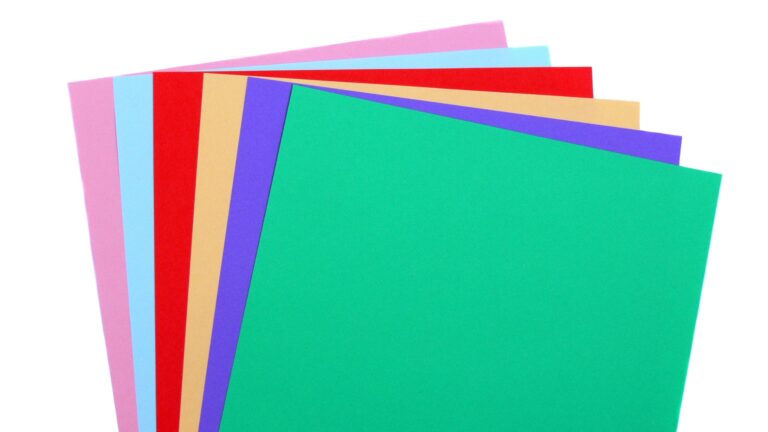Although we live in an increasingly digital world, paper still plays an incredibly important part in daily life for a huge number of people. Students use multiple kinds of paper throughout the day, from text and notebooks, through to printed exam sheets, to craft paper, art paper and more. Similarly, most office workers are in constant need of printer paper, notebooks and sticky notes.
Paper-like materials have been in use for around 5000 years thanks to the Egyptians and papyrus. Although like paper, papyrus is a woven mat of papyrus stems that is pounded flat, and sun dried. True paper isn’t thought to have arrived until around 3000 years later in China. This first paper was made from a mixture of mulberry bark, hemp waste and old rags.
The production of paper has become a great deal faster and more efficient than when it was first invented, but the general technique remains essentially the same. Plant matter is ground down into a wet pulp then formed into the desired paper shape. The water is then squeezed out of the pulp, leaving the interwoven plant fibres to knit together as it dries.
From its rather basic beginnings, paper has become an incredibly important and highly varied commodity, with an confounding number of specific paper terms and words that are used to describe it.
How is Paper Made?
Depending on the specific type of paper, the materials and machinery may vary but the technique for making most kinds of paper is the same. Some form of biomass – typically wood, but other materials such as bamboo, sugarcane, cotton, rags and more – are broken down into a fibrous pulp. This pulp is then formed into a paper shape and dried.
Industrial paper manufacture use presses to form, smooth and extract moisture while making paper. These presses may be either hot or cold. Cold presses result in paper that has a slightly rough or “toothy” texture that is also very good at absorbing water or ink. Cold pressed paper is well suited for artistic pursuits, such as watercolour painting or projects that don’t require fine line and detail.
Hot presses, like the name suggests, combine pressure and heat to both squeeze water from the pulp and dry the surface. Hot presses result in a smooth, non-absorbent paper. Printer paper and the paper in notebooks are fine examples of hot-pressed paper.
Paper Weight and Size
If you look on the box of a ream of printer paper, you’re likely to see two classifications or measurements printed on it. One will be a number followed by GSM – for printer paper, this will usually be between 70 and 100 – and a sizing, the most common of which is A4. These classifications represent the dimensions of the sheets of paper, with GSM showing weight, and the A(number) showing the height and width of the sheet.
GSM
Meaning Grams per Square Metre, GSM is an indicator of the thickness of a piece of paper. All GSM paper is measured by weighing a single one square metre piece of paper, with the resulting weight giving an indication of how thick the paper is – the heavier the one metre sheet, the thicker it is.
The thickness or heaviness of a sheet of paper can affect a number of properties of that sheet, including its rigidity – how resistant the sheet is as bending – to how much light can show through the paper. The normal ranges of GSM and the general purposes of that thickness of paper are shown below:
35-55 gsm – This is the lightest common form of paper. Examples of 35-55 gsm paper include tracing paper and newsprint. The lightest classification of GSM paper, ranges from tracing paper to newsprint.
75-90 gsm – Most forms of printing paper will fit within this range, as will the paper found in most notebooks and pads. The thickness of the paper is enough that it is suitable for printing and writing but isn’t heavy enough to stand out.
120-140 gsm – Posters, flyers and presentations are typically printed on 120-140 gsm paper. The thickness of the paper makes it feel premium without having to use special paper or card.
210-300 gsm – This thicker type of paper is stiffer but can still bend. You’ll see it used for high-end magazine covers and high-quality flyers. This is also the weight of most paper used for watercolours or painting.
350-450 gsm – The highest classification of GSM paper is pretty much cardstock. This is the heaviest, sturdiest paper available and is commonly used for business cards and invitations.
Paper Sizes
The most common sizing for paper internationally is referred to as ISO A, and the most used paper size is A4. So, what does this mean?
Sheets of ISO A paper range from A0 to A10, with each successive number being half the size of the ISO number that preceded it.
- A0: Sheets of A0 paper have a surface area of one square metre and dimensions of 1189mm x 841mm.
- A1: Primarily used for posters, A1 sheets have dimensions of 841mm x 594mm.
- A2: 594mm x 420mm. Used for smaller posters, maps, blueprints, diagrams and the like.
- A3: 420mm x 297mm. The largest common printing paper size.
- A4: 297mm x 210mm. The most commonly used paper size.
- A5: 210mm x 148mm. Primarily used for notebooks and pads, brochures and booklets.
- A6: 148mm x 105mm. Typical sizing for postcards and small flyers.
- A7: 105mm x 74mm. Primarily used for pocket notepads, sticky notes and greeting cards.
- A8: 74mm x 52mm. Used for business cards and labels.
Although ISO A is the most common format of paper used internationally, there are also other formats that are used, including ISO B and C, as well as the North American ANSI sizes.
Outside of specialty printing, ISO B and C are uncommon in Australia. ANSI sizes are also rarely used but can occasionally cause problems while printing. The “Letter” size that appears in the options of many printers is more properly referred to as ANSI A. Although ANSI A is close to A4 in dimension – 216mm × 279mm as opposes to 210mm x 297mm – the two sizes are not compatible.
Types of Paper
There are many different types of paper available, some of which are used for very specific purposes, and others which have broader use. Having the right paper for the right job ensures that you get the best results from your project.
Acetate Paper: Acetate paper isn’t technically paper but rather printable sheets of transparent acetate or mylar. Acetate is available in common ISO A paper sizes and is typically used for overhead projector sheets, stencils, cake collars and more.
Acid Free: Paper made from standard wood pulp is typically slightly acidic. This acid content is what causes paper to yellow, become brittle and break down as it ages. Acid free paper has a neutral pH of 7 or slightly higher, making it much more suitable for archival. Another name for acid free paper is archival paper.
Bond Paper: Bond paper is a type of high-quality, durable paper known for its smooth texture and heavier weight, typically made from a blend of wood pulp and cotton fibres. It is commonly used for various professional and business documents such as letterheads, legal documents, resumes, and business reports due to its excellent printing and writing properties.
Card stock: Card stock is a thick and sturdy type of paper, often heavier than standard printing paper, known for its durability and rigidity. It is commonly used for crafting, business cards, greeting cards, invitations, and as a base for projects requiring a more substantial and resilient material.
Kraft Paper: Kraft paper is a coarse and brownish paper made from unbleached wood pulp, known for its strength and natural appearance. It is commonly used for packaging, wrapping, and crafting due to its durability, eco-friendliness, and ability to provide a rustic, textured look to various products.
Printer Paper: Printer paper is a type of lightweight, smooth, and often bright white paper designed for use in printers and copiers. It is commonly used for producing documents, reports, letters, and other printed materials in both home and office settings due to its compatibility with various printing technologies and ease of handling.
Recycled Paper: Recycled paper is a type of paper made from recovered paper products like newspapers, magazines, and cardboard, which are processed to create new paper. It is commonly used for eco-friendly printing and writing purposes, including business documents, brochures, and packaging, as it helps reduce the demand for virgin pulp and helps minimise environmental impact.
Vellum Paper: Vellum paper is a translucent, smooth-textured paper. Originally made from animal hides, modern vellum is instead made from wood pulp like other papers. Vellum is commonly used for artistic purposes such as drawing, calligraphy, and crafting, as well as for creating decorative overlays in stationery, invitations, and architectural drawings due to its unique, semi-opaque appearance.
Paper Coatings
In addition to styles of paper, sheets can also have a coating that changes the appearance or properties of the paper. The most common coatings for paper are.
Matte: Matte coating is a type of finish applied to paper that results in a non-glossy, flat surface with minimal reflection and a smooth texture. It is commonly used to enhance readability in printed materials like brochures, posters, and photographs, providing a professional look while reducing glare and fingerprint visibility.
Gloss: A gloss coating is a glossy, reflective finish applied to paper to create a shiny and smooth surface. It is commonly used to enhance the vibrancy of colours and images in printed materials like magazines, catalogues, and product labels, giving them a polished and visually appealing appearance.
Silk: Essentially a mid-point between matte and gloss, silk coating is a matte finish with a subtle sheen, providing a smooth, low-gloss appearance to paper. It is often used in printing materials like brochures, flyers, and business cards to add an element of sophistication while reducing glare, making text and images easier to read and view.
Proper Paper Storage
Proper paper storage techniques are crucial to preserve the quality of paper and prevent issues related to humidity. When storing paper, it’s essential to keep it in a cool, dry, and stable environment. Here are some key considerations:
Temperature: Maintain a consistent temperature in the storage area. Fluctuations in temperature can cause paper to expand and contract, leading to warping or curling. Aim for a temperature between 18-24°C.
Humidity: Water typically makes up between 4% and 6% of a sheet of paper by weight. Excessive humidity can cause paper to absorb moisture from the environment, leading to buckling, warping, and mold growth. It may also encourage the growth of microorganisms, which can damage the paper’s integrity.
Insufficient humidity can cause paper to lose moisture, making it brittle and prone to tearing or cracking. This is particularly problematic for older or vintage documents.
A humidity level in paper storage areas between 45% and 55% can help maintain the integrity of stored paper.
Avoid Direct Sunlight: Exposure to direct sunlight can cause paper to fade and deteriorate over time. Store paper away from windows or use UV-resistant coatings if displaying in well-lit areas.
Elevated Shelves: Store paper on elevated shelves or pallets to protect it from potential water damage from leaks, flooding or spills.
Use Acid-Free Materials: If using folders, boxes, or envelopes for paper storage, ensure they are made from acid-free materials to prevent acid migration, which can cause yellowing and paper degradation.

